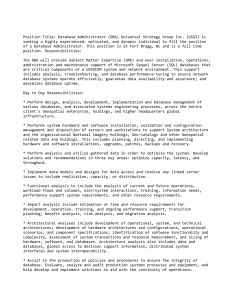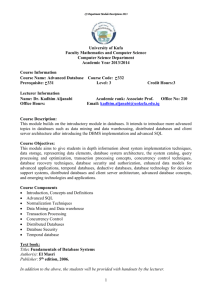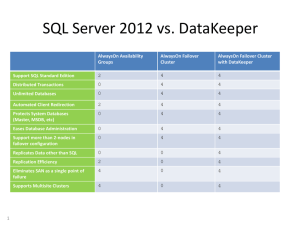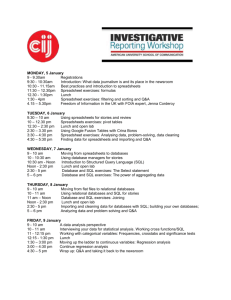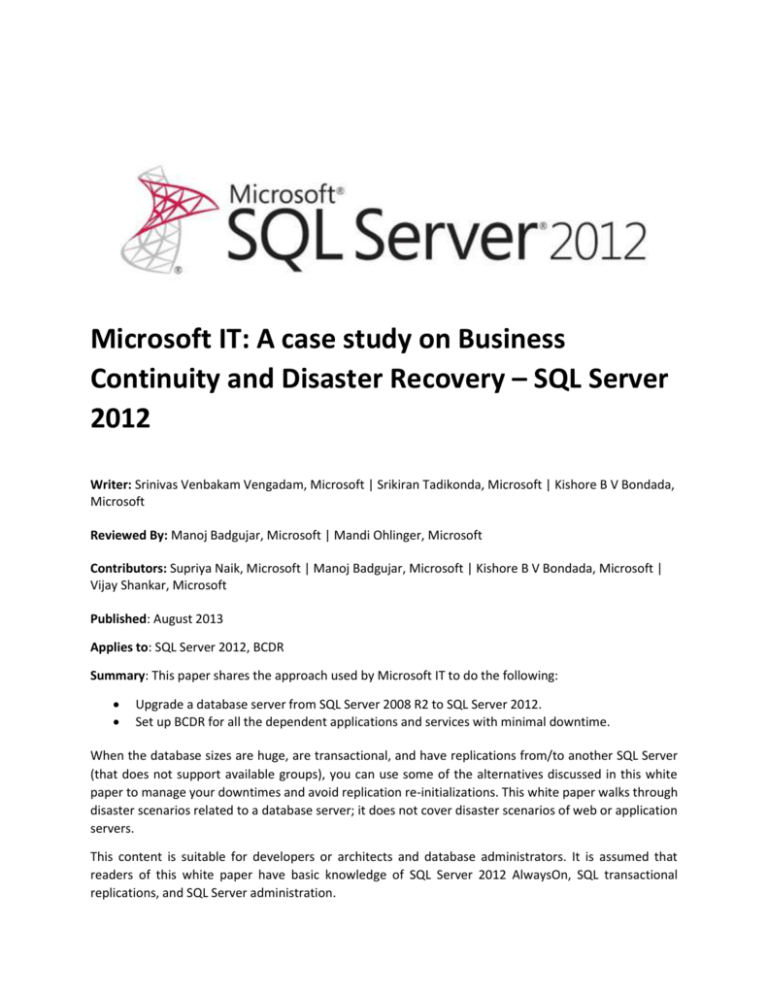
Microsoft IT: A case study on Business
Continuity and Disaster Recovery – SQL Server
2012
Writer: Srinivas Venbakam Vengadam, Microsoft | Srikiran Tadikonda, Microsoft | Kishore B V Bondada,
Microsoft
Reviewed By: Manoj Badgujar, Microsoft | Mandi Ohlinger, Microsoft
Contributors: Supriya Naik, Microsoft | Manoj Badgujar, Microsoft | Kishore B V Bondada, Microsoft |
Vijay Shankar, Microsoft
Published: August 2013
Applies to: SQL Server 2012, BCDR
Summary: This paper shares the approach used by Microsoft IT to do the following:
Upgrade a database server from SQL Server 2008 R2 to SQL Server 2012.
Set up BCDR for all the dependent applications and services with minimal downtime.
When the database sizes are huge, are transactional, and have replications from/to another SQL Server
(that does not support available groups), you can use some of the alternatives discussed in this white
paper to manage your downtimes and avoid replication re-initializations. This white paper walks through
disaster scenarios related to a database server; it does not cover disaster scenarios of web or application
servers.
This content is suitable for developers or architects and database administrators. It is assumed that
readers of this white paper have basic knowledge of SQL Server 2012 AlwaysOn, SQL transactional
replications, and SQL Server administration.
Copyright
This document is provided “as-is”. Information and views expressed in this document, including URL and
other Internet Web site references, may change without notice. You bear the risk of using it.
This document does not provide you with any legal rights to any intellectual property in any Microsoft
product. You may copy and use this document for your internal, reference purposes.
© 2013 Microsoft. All rights reserved.
Contents
Introduction .................................................................................................................................................. 4
Business Continuity and Disaster Recovery (BC/DR) .................................................................................... 4
Legacy Architecture: Database Mirroring for High Availability, Log Shipping for Disaster Recovery ........... 4
Limitations ................................................................................................................................................ 5
Current Architecture: AlwaysOn Availability Groups for High Availability and Disaster Recovery .............. 5
Benefits of AlwaysOn Availability Groups in SQL Server 2012 ..................................................................... 6
SQL Replication Techniques .......................................................................................................................... 7
HomeDepot Case Study ................................................................................................................................ 7
Context ...................................................................................................................................................... 7
Objective ................................................................................................................................................... 8
BCDR on HomeDepot ................................................................................................................................ 8
HomeDepot Architecture.......................................................................................................................... 9
BCDR Testing ........................................................................................................................................... 12
Failover................................................................................................................................................ 12
Failback ............................................................................................................................................... 14
Challenges ................................................................................................................................................... 16
Conclusion ................................................................................................................................................... 16
Appendix ..................................................................................................................................................... 16
Acknowledgements..................................................................................................................................... 17
Introduction
SQL Server 2012 added a set of features for High Availability (HA) and Disaster Recovery (DR). The
AlwaysOn feature is now available in a cluster environment and can be used to implement Business
Continuity and Disaster Recovery (BCDR) for critical applications and services. In addition to having the
databases highly available, there are different strategies to support BCDR so that an enterprise
application or service is available/recoverable with minimal downtimes and data loss.
This paper shares the approach used by Microsoft IT to do the following:
Upgrade a database server from SQL Server 2008 R2 to SQL Server 2012.
Set up BCDR for all the dependent applications and services with minimal downtime.
When the database sizes are huge, are transactional, and have replications from/to another SQL Server
(that does not support available groups), you can use some of the alternatives discussed in this white
paper to manage your downtimes and avoid replication reinitializations. This white paper walks through
disaster scenarios related to a database server; it does not cover disaster scenarios of web or application
servers.
This content is suitable for developers or architects and database administrators. It is assumed that
readers of this white paper have basic knowledge of SQL Server 2012 AlwaysOn, SQL transactional
replications, and SQL Server administration.
Business Continuity and Disaster Recovery (BC/DR)
BCDR are closely related practices that enable organizations to prepare for any unexpected events such
as earthquakes, terror attacks, national emergencies, and so on. In general, Disaster Recovery (DR)
refers to the specific steps taken to resume operations in the aftermath of disaster. Business Continuity
(BC) describes the processes and procedures an organization must put in place to ensure that missioncritical applications can continue during and after a disaster.
Legacy Architecture: Database Mirroring for High Availability, Log
Shipping for Disaster Recovery
Before SQL Server 2012, SQL Server deployment architecture uses Database Mirroring for high
availability and uses Log Shipping for disaster recovery. Database Mirroring is configured within the
primary data center and Log Shipping is configured within the cross-data center. To achieve automatic
failover, synchronous database mirroring with a witness (a third SQL Server instance) is configured.
When zero data loss is required, the database mirroring high-safety mode (synchronous) setting is
enabled to help ensure zero data loss between the two servers located in the primary data center. To
improve database availability within the primary data center, a third SQL Server instance is configured to
act as a witness to enable automatic failover between the database mirroring partners.
If a primary data center outage renders both database mirroring partner instances unavailable, log
shipping is used for disaster recovery. Log shipping involves ongoing transaction log backups of the
principal databases. These transaction log backups are then copied to a SQL Server instance in the
disaster recovery data center. Incoming transaction log backups are restored in sequence on an ongoing
basis. You could also choose to configure log shipping for read-only workloads, but read-only
connections must be disconnected before incoming transaction log backups can be applied. Figure 1
shows a representation of this solution architecture:
Figure 1: Database mirroring for high availability and log shipping for disaster recovery
More information on Database Mirroring can be found here
(http://msdn.microsoft.com/library/ms189852(v=sql.105).aspx) and Disaster Recovery can be found
here (http://msdn.microsoft.com/library/bb895393(v=sql.105).aspx).
Limitations
1. Database Mirroring does not allow reads on secondary server.
2. Log Shipping is used across data centers. As a result, there can be data loss that is equal to
the frequency at which log shipping job is scheduled.
3. Maintainability is low with log shipping because two jobs are created for every database on
the server.
4. Log shipping does not support automatic failover.
Current Architecture: AlwaysOn Availability Groups for High Availability
and Disaster Recovery
BCDR in SQL Server 2012 supports AlwaysOn Availability groups. The AlwaysOn Availability Groups
feature is a high-availability and disaster recovery solution that provides an enterprise-level alternative
to database mirroring. AlwaysOn Availability Groups maximizes the availability of a set of user databases
for an enterprise. An availability group supports a failover environment for a discrete set of user
databases, known as availability databases that fail over together. An availability group supports a set of
read-write primary databases and one-to-four sets of corresponding secondary databases. Optionally,
secondary databases can be made available for read-only access and/or some backup operations. More
information on AlwaysOn Availability Groups can be found here
(http://msdn.microsoft.com/library/ff877884.aspx).
Figure 2: Availability groups and Disaster recovery in SQL Server 2012
Benefits of AlwaysOn Availability Groups in SQL Server 2012
The following are some significant benefits of AlwaysOn Availability Groups in SQL Server 2012:
More than one user database can be grouped into a single unit of failover. In contrast, database
mirroring permits only one user database as a unit of failover.
Availability groups multiple secondary replicas enables users to unify the HA and DR solution
into one technology, instead of using multiple technologies used in SQL Server 2008 R2.
Secondary replicas can also be configured to permit read-only workloads to obtain close to realtime data. Unlike with log shipping, ongoing read-only connections to the secondary replicas can
be active to see ongoing data modifications against the primary replica. Secondary replicas can
also be used to offload full database and transaction log backup operations.
Availability groups and the associated availability group listener support automatic client
redirection to the primary replica or redirection to available readable secondary replicas.
Availability group listeners remove the need to designate a failover partner in the client
connection string.
Up to five availability replicas are supported. An availability replica is an instantiation of an
availability group that host a specific instance of SQL Server and maintains a local copy of each
availability database that belongs to the availability group. Each availability group supports one
primary replica and up to four secondary replicas.
Encryption and compression are supported; which provide a secure, high performing transport.
More information on the benefits is available here
(http://msdn.microsoft.com/library/hh510230.aspx#Benefits).
SQL Replication Techniques
SQL Replication is a process of copying and distributing data and data objects from one database to
another; and then synchronizing both the databases for consistency. Through SQL Replication, you can
achieve high-availability, application performance, and so on.
There are three types of SQL Replications:
Snapshot Replication
Transactional Replication
Merge Replication
Refer to the Appendix at the end of this white paper for details on Replication.
HomeDepot Case Study
Context
HomeDepot is a critical data warehouse server that distributes product data across all the Microsoft IT
systems in the enterprise. Currently, it has around 1 TB of data, 7000 SQL objects, and acts as an
upstream for various external systems, including enterprise data warehouse, SAP, and systems that
exchange data that uses flat files in Excel. The HomeDepot server stores different types of databases,
including static and Transactional (which include small and large databases). BCDR setup and testing has
never been conducted for the HomeDepot server due to these multiple dependent systems. Loss of the
HomeDepot server due to a disaster negatively impacts customers and can result in loss of key data. To
maintain business continuity and better IT manageability, a replica server outside datacenter and a
technical upgrade on all the databases are required.
Figure 3: HomeDepot Server
Objective
Migrate the HomeDepot database server from SQL Server 2008 R2 to SQL Server 2012.
Using Geographic Redundancy, enable High Availability (HA) and Disaster Recovery (DR) with
minimal loss of data.
Minimize downtime by reducing Recovery Time Objective (RTO) and Recovery Point Objective
(RPO).
BCDR on HomeDepot
Industry best practices, including failover clustering, database mirroring, log shipping, peer-to-peer
replication, and AlwaysOn are considered:
Failover Clustering - A failover cluster is a group of independent computers that work together to
increase the availability and scalability of clustered roles (formerly called clustered applications and
services). The clustered servers (called nodes) connect to physical cables and by software. If one or more
of the cluster nodes fail, other nodes begin to provide service (a process known as failover). The
drawback of failover clustering is using shared-storage devices, like a storage area network (SAN); which
could be a single point of failure.
Database Mirroring – Mirroring is a High availability solution used in SQL 2008 R2 but depreciated in
SQL 2012.
Log Shipping - Log shipping allows you to automatically send transaction log backups from a primary
database on a primary server instance to one or more secondary databases on separate secondary
server instances. The transaction log backups are applied to each of the secondary databases
individually. Log Shipping is used for Large and replicated databases in HomeDepot.
Peer-to-peer replication – Peer-to-peer replication provides a scale-out and high-availability solution by
maintaining copies of data across multiple server instances, also referred to as nodes. Built on the
foundation of transactional replication, peer-to-peer replication propagates transactionally consistent
changes in near real-time. This enables applications that require scale-out of read operations to
distribute the reads from clients across multiple nodes. Because data is maintained across the nodes in
near real-time, peer-to-peer replication provides data redundancy, which increases the availability of
data.
AlwaysOn - The AlwaysOn Availability Groups feature is a high-availability and disaster-recovery solution
that provides an enterprise-level alternative to database mirroring. AlwaysOn Availability Groups
maximizes the availability of a set of user databases for an enterprise. An availability group supports a
failover environment for a discrete set of user databases, known as availability databases that fail over
together. AlwaysOn is used for High Availability in HomeDepot.
To achieve High Availability, AlwaysOn is chosen. For Disaster Recovery, the replications on the
secondary server are reinitialized using a Log Sequence Numbering (LSN)-based approach.
HomeDepot Architecture
In HomeDepot, the databases are separated into three categories:
Static Databases: Static Databases contain configuration tables that are used by other
databases. They are not used by any external applications. HomeDepot has three small static
databases.
Transactional Non-Replicated Databases: Transactional Non-Replicated databases contain
tables where external applications perform read-write operations. HomeDepot has such
databases whose size ranges from 2 GB to 70 GB.
Transactional Replicated Databases: Transactional Replicated Databases contain tables that get
data from another database server (to which upstream applications feed data) through pull or
push subscriptions. HomeDepot has seven such databases whose size ranges from 2 GB to 70
GB.
HomeDepot gets data from eight upstream applications and provides data to four downstream
applications. HomeDepot has 18 SQL Jobs that perform data operations.
The architecture of HomeDepot server on SQL Server 2008 R2:
Figure 4: HomeDepot Server architecture before BCDR.
After migrating to SQL Server 2012 and enabling BCDR, the architecture consists of the following:
Figure 5: HomeDepot Server architecture after BCDR.
Primary Server: A primary HomeDepot server that contains all the databases and SQL objects is
described in the Architecture.
Primary Replica: An exact copy of the primary HomeDepot server. The primary server and primary
replica communicate with each other synchronously.
The primary server and primary replica exist in the same datacenter.
Secondary Replica: An exact copy of the primary server. It communicates with primary server in
asynchronous mode. The secondary replica is kept in different datacenter to achieve Geo-redundancy.
HomeDepot uses a publisher-subscriber model for transactional replication.
The following steps are used to migrate from SQL Server 2008 R2 to SQL Server 2012:
1. Installed Windows Service Failover Cluster (WSFC) on the new HomeDepot server. This blog
(http://blogs.msdn.com/b/srinivas-v-v/archive/2013/06/25/setting-up-always-on-availabilitygroup-on-sql-server-2012.aspx) lists the step-by-step procedures.
2. Configured the databases to use the Full recovery model with differential backups.
3. Copied the static and transactional nonreplicated databases backups and restored them on new
servers using powershell scripts.
4. After restoring the databases on the new servers, restored SQL server-level logins and roles on
the new SQL Server 2012 server using sp_help_revlogin
(http://support.microsoft.com/kb/918992).
5. SQL Agent jobs are scripted out and recreated in the new server, SSIS packages are redeployed
with appropriate connection settings, and new file shares (DFS and non-DFS) are created on the
new server.
The migration is complete and the new HomeDepot server is ready.
To set up the new environment for BCDR, did the following:
1. AlwaysOn feature is enabled on the primary server. The step-by-step procedures are listed at
this blog (http://blogs.msdn.com/b/srinivas-v-v/archive/2013/06/25/setting-up-always-onavailability-group-on-sql-server-2012.aspx).
2. For static databases, took a backup from the primary server and restored it on the primary
replica and secondary replica using SQL server backup and restore feature. As static databases
are of a small size, backup and restore took less time.
3. After databases are restored, they are in recovery mode. To bring them online, the “Restore
database [$db] with RECOVERY” SQL Command is used.
4. Added these static databases to the Availability Group (AG) using PowerShell script; which can
be done either with a PowerShell script or using SSMS.
5. For copying transactional replicated and nonreplicated databases to the primary replica and
secondary replica, log shipping is used. For the step-by-step procedure used for log shipping,
refer this blog (http://blogs.msdn.com/b/srinivas-v-v/archive/2013/06/17/log-shipping-for-sqlserver.aspx) .
6. Break the log shipping. Bring all transactional replicated and nonreplicated databases on
primary replica and secondary replica online.
7. Add these transactional replicated and nonreplicated databases to the AG using PowerShell
script; which can be done either with a PowerShell script or using SSMS.
8. Set up replication on the transactional replicated databases. For the step-by-step procedure,
refer to this blog (http://blogs.msdn.com/b/srinivas-v-v/archive/2013/06/25/sql-serverreplication.aspx).
BCDR Testing
BCDR testing is performed to ensure that the system meets the Service Level Agreements (SLA),
including a disaster scenario or when system maintenance requires the system to stop. BCDR testing is
performed through Failover and Failback.
Failover
When the primary server is down (due to a disaster a patching issue), failover to the secondary server or
the disaster recovery server is completed. Then, drop the old subscriptions:
1. Check if the secondary server on the primary datacenter is up or the entire primary datacenter
is down. If the primary server is down, the replications can break. During planned downtime
windows (for example, patching operations), you can choose to wait until the primary server is
up and running or reinitialize replication on the new primary server.
2. If the secondary server on the primary datacenter is still up and running, then execute the
following command:
ALTER AVAILABILITY GROUP [$(ag_name)] FAILOVER;
3. If the entire primary datacenter is down, force quorum on one of the DR nodes and ensure that
the nodes in the primary data center do not form their own quorum.
Figure 6: Vote count indicating primary server not forming its own quorum.
When you open Failover Cluster Manager on a disaster recovery node, it may not provide useful
information (initially) on the state of the Failover Cluster because the cluster no longer has
quorum:
To enable Quorum on the Failover Cluster node, execute the following command on DR node:
Start-ClusterNode –Name "DRNODE1" –FixQuorum
You should see output similar to the following:
Name
State
-------
--------
drnode1
Joining
Note: If the cluster service is still running on “DRNODE1”, you can use the following Windows
PowerShell command to stop the service before you start the cluster service again with force
quorum:
Stop-ClusterNode –Name "DRNODE1"
If a data loss risk is acceptable and the service must be restored at the data center, execute the
following T-SQL syntax at the disaster recovery Failover Cluster Instance (FCI) to force failover:
ALTER AVAILABILITY GROUP [AG1] FORCE_FAILOVER_ALLOW_DATA_LOSS;
4. Modify the Windows Server Failover Cluster (WSFC) voting configuration on the DR Node.
5. Re-initialize the SQL replication using LSN on the new primary server. Follow this blog
(http://blogs.msdn.com/b/srinivas-v-v/archive/2013/06/25/re-initialization-with-log-sequencenumbering-lsn-for-sql-server-failover.aspx) for details.
6. Enable the SQL Agent jobs on the new primary server.
Note: If your server has dependent file shares, it is good to have them on Distributed File system (DFS).
The advantage is that during failover and failback, the files shares are still available.
Failback
When the primary data center issues are resolved and the nodes in the primary data center are enabled,
the nodes attempt to connect to the Windows Server Failover Cluster (WSFC). After they are
reconnected to the WSFC with the cluster services running, the node weights assigned at the disaster
recovery node should be in effect. This scenario also assumes that the original SQL Server installations
and associated databases are still intact.
Failback steps include:
1. Start the controlled migration back to the primary data center by adding back the quorum votes
to the two primary data center nodes. After configuring this setting, verify that all nodes in the
WSFC have a vote.
2. To resume each database that participates in the availability group, execute the T-SQL ALTER
DATABASE commands on the primary data center Failover Cluster Instance (FCI):
ALTER DATABASE AppDB SET HADR RESUME;
GO
ALTER DATABASE ConfigDB SET HADR RESUME;
GO
ALTER DATABASE ReportDB SET HADR RESUME;
GO
3. To synchronize before failover, modify the availability group on the DR FCI to temporarily use
the synchronous commit availability mode:
ALTER AVAILABILITY GROUP [AG1] MODIFY REPLICA ON
N'SQLFCIPrimary\INST_A' WITH (AVAILABILITY_MODE =
SYNCHRONOUS_COMMIT);
Tip
The synchronous commit setting should be made during a period of low application activity to
minimize the impact of transaction latency on users.
4. Confirm the synchronization status between the two locations:
SELECT role_desc,synchronization_health_desc
FROM sys.dm_hadr_availability_replica_states;
Both replica states should say “healthy” before moving to the next step; meaning that both
synchronous-commit replicas are synchronized.
5. To fail over from the disaster recovery data center FCI to the former primary data center FCI,
connect and execute the following script on the primary data center FCI:
ALTER AVAILABILITY GROUP [AG1] FAILOVER;
The primary data center FCI becomes the new primary replica.
6. If your topology uses high-performance mode, as mentioned earlier, change the disaster
recovery FCI replica node back to asynchronous commit. Execute the following Transact-SQL on
the primary replica:
USE [master]
GO
ALTER AVAILABILITY GROUP [AG1]
MODIFY REPLICA ON N'SQLFCIDR\INST_B' WITH
(AVAILABILITY_MODE = ASYNCHRONOUS_COMMIT);
GO
USE [master]
GO
ALTER AVAILABILITY GROUP [AG1]
MODIFY REPLICA ON N'SQLFCIPrimary\INST_A' WITH
(AVAILABILITY_MODE = ASYNCHRONOUS_COMMIT);
GO
7. Remove quorum votes from the disaster recovery nodes.
8. Once the failback is complete, use the following steps for Log Sequence Numbering (LSN) to
reinitialize the subscriber:
a)
b)
c)
d)
Validate the LSN with the distributor.
Clean up the new subscriber.
Add subscription for the new subscriber on the publisher.
Check the type of subscription and add appropriate subscription agents:
i. Check the subscription agent at subscriber.
ii. Check the subscription agent at publisher.
This blog (http://blogs.msdn.com/b/srinivas-v-v/archive/2013/06/25/re-initialization-with-logsequence-numbering-lsn-for-sql-server-failover.aspx) lists the details and scripts used in this
step.
9. Modify the WFSC voting configuration.
10. Configure DFS to point to the file location on new primary server.
11. Set up the replication on new primary server.
12. Enable the SQL Agent jobs on new primary server.
Challenges
A split brain scenario is one of the challenges in this HomeDepot BCDR.
Split brain is a typical scenario that occurs during a network outage at the primary datacenter. The
underlying databases at the primary datacenter are still online and are not able to communicate with
the DR site.
A sample split brain scenario includes:
1. Failover to DR node takes place. The Availability Group (AG) is up and running on the DR node.
2. Voting configuration for DR and PR node is changed.
3. If the network comes back at the primary datacenter, both sites have their own copy of the
availability group and the group is accessible.
This scenario can cause serious data consistency problems.
The only clean way to come out of this scenario involves the physical presence of an on-site support
team. The support team manually takes the nodes at the primary data center down or out of network.
Then, do manual changes before bringing up the nodes in a specific order with a quorum vote of 0 and
prevent the quorum setting. But, this solution may not be a viable solution during a real disaster.
Conclusion
This case study describes how a critical Microsoft IT database server is moved to SQL Server 2012 and
BCDR is enabled for all the dependent applications and services.
SQL Server 2012 has significant enhancements to support High availability scenarios. This white paper
describes the enhancements to the High availability and Disaster Recovery features of SQL Server 2012
and explained approaches related to failover/failback for Business Continuity and Disaster Recovery.
This white paper also enlists different dependencies on a typical enterprise database server, like
databases (categorized as large, transactional, static, and small), Server objects (like SQL jobs,
logins/roles, linked servers, file system dependencies, SSIS packages), replications from a prior version of
SQL Server that move large data from/to SQL Server, applications connecting to the database server,
and different strategies to allow fail-over and failback of applications/services during a disaster. You can
refer to the blog references in this white paper to learn the step-by-step processes for different aspects
of SQL Server 2012 AlwaysOn.
Appendix
Recovery Time Objective (RTO): Recovery time objective is the time period in which a system has to be
restored after disaster. Any further delay in restoring the system can result in loss of information.
Recovery Point Objective (RPO): Recovery point objective defines the maximum tolerable time limit
after which data might be lost. Reduced value of RPO refers to the need for high availability.
Snapshot Replication: Snapshot replication distributes data exactly as it appears at a specific moment in
time and does not monitor for updates to the data. Snapshot replication is best used to replicate data
that changes infrequently or when the most current values (low latency) are not required. When
synchronization occurs, the entire snapshot is generated and sent to Subscribers. For more details on
snapshot replication, refer to this (http://msdn.microsoft.com/library/ms151832.aspx).
Transactional Replication: Transactional replication typically starts with a snapshot of the publication
database objects and data. As soon as the initial snapshot is taken, subsequent data changes and
schema modifications made at the Publisher are delivered to the Subscriber as they occur (in near real
time). The data changes are applied to the Subscriber in the same order and within the same transaction
boundaries as they occurred at the Publisher. Within a publication, transactional consistency is
guaranteed. For more details on Transactional replication, refer to this
(http://msdn.microsoft.com/library/ms151176.aspx).
Merge Replication: Merge replication, like transactional replication, typically starts with a snapshot of
the publication database objects and data. Subsequent data changes and schema modifications made at
the Publisher and Subscribers are tracked with triggers. When connected to the network, the Subscriber
synchronizes with the Publisher and exchanges all rows that have changed between the Publisher and
Subscriber since the last synchronization occurred. For more details on Transactional replication, refer
to this (http://msdn.microsoft.com/library/ms152746.aspx).
Acknowledgements
Many thanks for the technical information and input provided by Kishore B V Bondada, Manoj Badgujar,
Supriya Naik and Vijay Shankar. We would like to acknowledge the leadership and support provided by
Kishore B V Bondada. A special thanks to Mandi Ohlinger for the technical review and valuable insights
on this white paper.
For more information:
http://www.microsoft.com/sqlserver/: SQL Server Web site
http://technet.microsoft.com/en-us/sqlserver/: SQL Server TechCenter
http://msdn.microsoft.com/en-us/sqlserver/: SQL Server DevCenter
Did this paper help you? Please give us your feedback. Tell us on a scale of 1 (poor) to 5 (excellent), how
would you rate this paper and why have you given it this rating? For example:
Are you rating it high due to having good examples, excellent screen shots, clear writing, or
another reason?
Are you rating it low due to poor examples, fuzzy screen shots, or unclear writing?
This feedback will help us improve the quality of white papers we release.
Send feedback.



